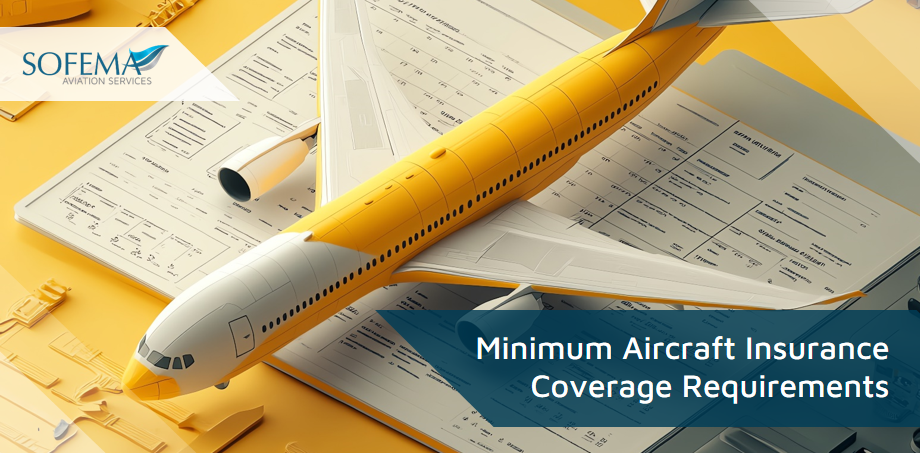Sofema Aviation Services (SAS) www.sassofia.com considers the Minimum Aircraft Insurance Coverage Requirements in Aviation.
Introduction – Regulatory Requirements:
Minimum aircraft insurance coverage requirements and including lessors as additional insureds are crucial aspects of aviation insurance, ensuring comprehensive protection for all parties involved.
- International Regulations: The International Civil Aviation Organization (ICAO) sets global standards for aviation insurance.
- For instance, the Montreal Convention requires airlines to have minimum insurance coverage for passenger liability.
- National Regulations: Individual countries have specific regulations mandating minimum insurance coverage. ( The EU requires airlines to have minimum insurance coverage for passenger, baggage, cargo, and third-party liability.)
Types of Coverage:
- Passenger Liability: Covers injury or death of passengers. Minimum coverage is often mandated per passenger.
- Third-Party Liability: Covers damage to third parties (people or property) on the ground. The amount required depends on the aircraft’s maximum takeoff weight (MTOW).
- Hull Insurance: Covers physical damage to the aircraft itself. While not always mandated by law, it is typically required by lessors and financiers.
- Cargo Liability: Covers loss or damage to cargo. Minimum coverage may be required depending on the nature of the cargo and the routes flown.
Specific Minimums:
- Passenger Liability: For instance, under EU regulations, the minimum is approximately €250,000 per passenger.
- Third-Party Liability: Varies significantly based on the aircraft size and operation type, ranging from €750,000 to over €700 million.
- Combined Single Limit (CSL): Some regulations may stipulate a combined minimum coverage amount for all liabilities, simplifying compliance but ensuring comprehensive coverage.
Naming Lessors as Additional Insured – Importance for Lessors:
- Risk Mitigation: By being named as additional insured, lessors ensure they are protected against financial loss resulting from incidents involving the leased aircraft.
- Control Over Insurance: This provision gives lessors a degree of control and assurance that the lessee maintains adequate insurance coverage.
Common Provisions:
- Additional Insured Clause: This clause includes the lessor as an additional insured under the lessee’s policy. It ensures that the lessor has the same protection as the lessee in the event of a claim.
- Loss Payee Clause: Often, lessors are also named as loss payees, meaning any insurance payout for hull loss or damage is made directly to the lessor or jointly to both the lessor and lessee.
- Waiver of Subrogation: Insurers waive their right to seek compensation from the lessor for any paid claims, preventing insurers from suing the lessor to recover costs.
Benefits for Lessors:
- Enhanced Security: Ensures that the lessor’s financial interests are protected without relying solely on the lessee’s financial stability.
- Direct Access to Payouts: Guarantees that insurance proceeds are used to repair or replace the aircraft, maintaining the asset’s value.
- Peace of Mind: Provides assurance that comprehensive coverage is maintained, reducing exposure to potential financial loss from legal claims.
Benefits for Lessees:
- Facilitates Leasing: Agreeing to these provisions is often a prerequisite for securing a lease, making it easier for airlines to acquire aircraft.
- Operational Continuity: Ensures that adequate insurance coverage is in place, minimizing disruptions from uninsured incidents.
Challenges and Considerations:
- Cost Implications: Including lessors as additional insureds can increase insurance premiums as it broadens the coverage scope.
- Policy Complexity: Managing insurance policies with additional insured provisions can be complex, requiring detailed attention to policy terms and conditions.
- Compliance and Updates: It is necessary to regularly review and update insurance policies to ensure continued compliance with regulatory requirements and lease agreements.
Best Practices
Thorough Contract Review:
- Detailed Clauses: Ensure that lease agreements clearly outline the insurance requirements, including minimum coverage levels and specific clauses for naming lessors as additional insured and loss payees.
- Regular Audits: Conduct regular audits of insurance policies to confirm compliance with lease agreements and regulatory requirements.
Effective Communication:
- Insurer Coordination: Maintain open communication with insurers to ensure that all policy provisions are clearly understood and accurately implemented.
- Stakeholder Updates: Keep all stakeholders, including lessors and regulatory bodies, informed about any changes to insurance coverage or terms.
Legal and Financial Advice:
- Expert Consultation: Engage legal and financial advisors to navigate the complexities of aviation insurance, ensuring that all contractual and regulatory obligations are met.
- Customized Solutions: Work with insurance brokers to tailor policies that meet specific operational needs while complying with all relevant requirements.
Continuous Monitoring:
- Risk Assessment: Continuously monitor and assess risks to adjust insurance coverage as needed, ensuring adequate protection in a dynamic operating environment.
- Policy Renewal: Ensure timely renewal of policies with necessary adjustments to coverage limits and provisions based on updated risk assessments and operational changes.
Next Steps
Follow this link to our Library to find & download related documents for Free.
Sofema Aviation Services (www.sassofia.com) and Sofema Online (www.sofemaonline.com) provide Classroom, Webinar, and Online Training related to Aircraft Lease and Maintenance Reserves. Please see the websites or email Team@sassofia.com. Check the following course here – Aircraft Leaseholder & Maintenance Reserve Insurance Considerations – Essentials.
Tags:
Cargo Liability, Leaseholder Insurance, Leasing Aircraft Insurance, Insurance Compliance, Loss Payee Clause, Aviation Risk Mitigation, EU Insurance Regulations, ICAO Regulations, Montreal Convention, Aircraft, Aircraft Lease Insurance, Insurance Coverage, Aircraft Hull Insurance, Aircraft Insurance, Aviation Insurance, Sofema Aviation Services (SAS), SAS blogs, aviation





